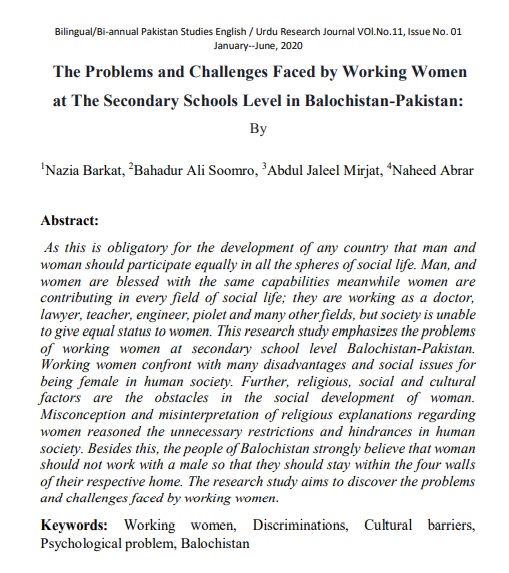The Problems and Challenges Faced by Working Women at The Secondary Schools Level in Balochistan-Pakistan:
Keywords:
Working women, Discriminations, Cultural barriers, Psychological problem, BalochistanAbstract
As this is obligatory for the development of any country that man and
woman should participate equally in all the spheres of social life. Man, and
women are blessed with the same capabilities meanwhile women are
contributing in every field of social life; they are working as a doctor,
lawyer, teacher, engineer, piolet and many other fields, but society is unable
to give equal status to women. This research study emphasizes the problems
of working women at secondary school level Balochistan-Pakistan.
Working women confront with many disadvantages and social issues for
being female in human society. Further, religious, social and cultural
factors are the obstacles in the social development of woman.
Misconception and misinterpretation of religious explanations regarding
women reasoned the unnecessary restrictions and hindrances in human
society. Besides this, the people of Balochistan strongly believe that woman
should not work with a male so that they should stay within the four walls
of their respective home. The research study aims to discover the problems
and challenges faced by working women.
References
Afshar, H. (1985). The position of women in an Iranian village. In. pp.66-
, Tavistock Publishers, London.
Akhtar, T. (1992). A study into the socio-economic problems of career
women with rural background. Department of Rural Sociology,
University of Agriculture, Faisalabad, Pakistan.
Chakraborty, S. (2013). Empowering the tribal women through education:
Issue of social justice with reference of West Bengal. Afro Asian
Journal of Anthropology and Social Policy, 4(1), 24-28.
Faridi, M. Z. & Rashid, A. (2014). The correlates of educated women’s
labor force participation in Pakistan: A micro-study. The Lahore
Journal of Economics, 19 (2), 155-184.
Gaetano, A. M., & Jacka, T. (Eds.). (2013). On the move: Women and ruralto-urban migration in contemporary China. Columbia: Columbia
University Press.
Gilbert, N. (2001). Researching social life. 2
nd Edn. Sage, London.
Maqsood, R., Bushra C., Zia, Q., & Cheema, A. (2005). Problems of
employed women at Faisalabad–Pakistan. Journal of Agriculture &
Social Sciences, 1(3), 245-247.
Mirjat, A. J., Soomro, B. A. & Mangi, S. (2019). Analysis of socioeconomic problems affecting women in agriculture: A case study of
Ghotki, Sindh, Pakistan. International Journal of Research and
Innovation in Social Science, 3(4), 229-232.
Nasreen, N. (1991). Nirbachita Column. Dhaka, Vidyaprakash, pp.27-28.
Nawaz, M.A., Afzal, N., Shehzadi, K. (2013). Problems of formally
employed women: a case study of Bahawalnagar, Pakistan. Asian
Journal of Empirical Research, 3(10), 1291-1299
Puspadjuita, E. A. R. (2018). Factors that influence the rate of
unemployment in Indonesia. International Journal of Economics and
Finance, 10(1), 140-147.
Qaisrani, A., Liaquat, S., & Khokhar, E. N. (2016). Socio-economic and
cultural factors of violence against women in Pakistan. Working paper
# 158, First edition: August 2016, www.sdpi.org
Sadruddin (2013). Sexual harassment at workplace in Pakistan: Issues and
remedies about the global issue at managerial sector. Journal of
Managerial Science, 7(1), 113-125.
Shamroza, S. (1993). Problems of women of rural areas of lower Sindh.
Pakistan Study Center, University of Karachi.
Shyamalie, H. W., & Saini, A. S. (2011). Socio-economic status and
livelihood security of women in the hills of India and Sri Lanka. New
Delhi: Readworthy.
Soomro, B. A., Anwar, S. & Rajar, A. A. (2019). Challenges for women
entrepreneurs in Pakistan: An empirical approach. The Women- Annual
Research Journal of Gender Studies, 11(11), 194-209.
Tomlinson, B. R. (2013). The economy of modern India: From 1860 to the
Twenty-first Century (Vol. 3). New Delhi: Cambridge University Press.



